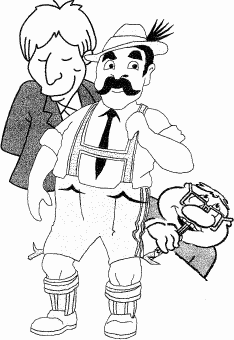|
It was the Spring of 1952 and I was Supervisor of Accounting for GE's Electronics Laboratory in Syracuse, New York. Fortune Magazine had published an article by Massachusetts Institute of Technology (MIT) mathematician Norbert Wiener extolling the virtues of "Cybernetics" in solving business problems. Cybernetics was his term for "Operations Research" , a cross academic discipline approach that the military had used in World War II to successfully solve some gun control problems.Ralph Cordiner, GE's Chairman, had read the article and thought that GE should give it a try. Somehow it fell to the Electronics Laboratory to perform the experiment. Consequently, a multi-disciplinary team was formed which consisted of Dr. Henry Samuleon, a very militaristic and formal German electrical engineer with a heavy accent; Dr. Paul Weiss, an absent minded Austrian theoretical physicist with an incomprehensible accent; Dr. Bob Fong, a Chinese mathematician, who never spoke so I can't vouch for his accent; and me as the "business man" (and interpreter).Dr. Henry Samuleon was always impeccably dressed and, though of average height, appeared taller due to his military bearing. Dr. Paul Weiss, whose clothes looked as if they'd been slept in, was a very big man with a cherubic face and unruly hair who walked stoop shouldered always in deep thought. Dr. Bob Fong was short and chubby and his clothes, in addition to looking slept in, bore the evidence of several recent meals. I felt as if I was the only normal member of the team. Henry assumed the leadership position as he was convinced that he spoke flawless and accentless English and couldn't understand why others didn't understand him. He undertook his assignment and position with customary Germanic authority and importance and we set off as a team with a charter to solve the business problems of GE's Electronics Division.First stop was the television business. It was a typical dreary late Spring Syracuse day, half raining and half snowing, as we tramped across the campus-like Electronics Park to building 5 which housed the television manufacturing department. Henry, with his militaristic bearing, carrying a black umbrella and with black rubbers over his shoes, led the procession into Walt Peterson's (the General Manager) office. I didn't know whether to be proud or embarrassed at being a member of the team. Walt's face was awash with mixed emotions as we were introduced. He didn't know whether to laugh, take us seriously or be concerned that we were some bizarre assemblage there at Cordiner's behest to oust him from his job!With Henry doing the talking, and me interpreting, we were able bit by bit to explain our mission to Walt. He listened politely and then allowed as how he didn't have any problems that we could help him with. As we tramped back across the Park to the Electronics Laboratory, I could only imagine Walt Peterson burning up the phone lines to the other General Managers laughing that we were going to solve their problems and alerting them of our impending visits.We ultimately did find a suitable problem in the germanium diode manufacturing plant in Clyde, New York. I won't go into the technical aspects of the problem except to say that it involved trying to optimize production with varying product yields, price levels and marketing requirements.My contribution was manually preparing voluminous spread sheets -this was before personal computers (or computers) - of production data for Bob Fong and Paul Weiss to analyze. Henry Samuleon's contribution was to insist on my right to whatever information I wanted. Bob Fong proved several new theorems in the mathematical field of Linear Programming so that he could use some of those methods in the solution to the problem. I'm not sure what Paul Weiss contributed as he and Bob Fong, who could not understand each other's vernacular, conversed entirely in the language of mathematics. I then documented the steps that the production people would need to follow to calculate future production schedules (using Marchant calculators). To my knowledge, this was one of the few successful efforts at applying operations research to a business problem although for awhile it became a faddish academic discipline with many Ph.D.'s earned in the field. I WOULD GIVE ANYTHING FOR A PICTURE OF US AS WE PARADED INTO WALT PETERSON'S OFFICE. |

